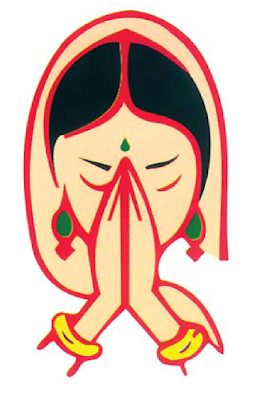Jain Symbols
JAI JINENDRA - GREETING
 |
| JAI JINENDRA |
Jai Jinendra literally means, “May the religion
established by the Jina prevail in our hearts”. As we
greet others we say, “Jai Jinendra” because we see an
image of a Jina, destroyer of all inner enemies, in them.
Recognizing this, we bow down with respect to their
Soul. Every Soul is capable of becoming a Jina, the
destroyer of inner enemies; anger, greed, ego, and
deceit. Jina is also known as Arihanta or Tirthankar. We
consider them as Jain Gods.
JINÄLAYA - JAIN TEMPLE(Deräsar or Mandir)
 |
JINALAYA |
A Jinälaya, Deräsar, or Mandir is a
place of worship where a person experiences
immense peace and serenity.
The images of Tirthankars and the
temple’s environment promote introspection and
bring home the feeling that God resides within
one’s own heart. Therefore, each person can
follow a path of purification of the inner self
devoid of anger, greed, ego, deceit, and
attachment from their lives.
OM
 |
| OM |
Om means completeness. It is a
symbolic word meaning infinite, the perfect,
and the eternal. The very sound is complete,
representing the wholeness of all things.
Upon attaining absolute knowledge or
omniscience, the body of the Arihanta
emanates Om (called the Divine Sound -
Divya Dhwani). It is an involuntary,
spontaneous, and melodious sound that all
humans, animals, and heavenly beings can
understand as a sermon, in their own language.
Om sounds like Aum, which is the
seat of the five benedictions (salutations of
supreme beings) and is made up of five
sounds and letters: a, a, ä, u, and m:
• The first letter “a” represents Arihanta (a human being who has
realized the true nature of the soul and reality and has conquered
passions).
• The second “a” represents Ashariri (Siddha, a liberated soul who does not have a physical body)
• The third letter “ä” represents Ächärya (an ascetic who is head of the Jain congregation).
• The fourth letter “u” represents Upädhyäy (an ascetic teacher).
• The fifth letter “m” represents Muni (Sädhus or Sädhvis who
practice Jain principles).
The Om represents a salutation to the five revered personalities in the Jain religion. Om is a shortened form of the Namokär Mantra.
HRIM
 |
| HRIM |
The word Hrim is a seed mantra. It is called
Hrimkär mantra.
It is a mystical symbol representing the invisible
sound, infinity, and divine energy of the 24 Tirthankars.
While meditating on Hrim, one can experience the
sublimating energy of Tirthankars.
Hrimkär mantra.
It is a mystical symbol representing the invisible
sound, infinity, and divine energy of the 24 Tirthankars.
While meditating on Hrim, one can experience the
sublimating energy of Tirthankars.
ARHAM
 |
ARHAM |
The word ARHAM is a mantra
representing all vowel and consonant
sounds used in the Sanskrut alphabet. The
first vowel in the Sanskrut alphabet is “a” and
the last consonant is “h.” Therefore, while
meditating on this mantra, one focuses on the
silent sound of the universe
SWASTIKA
 |
SWASTIKA |
The Swastika is considered an auspicious and a pious
symbol. The red arms of the swastika represent the four
possible states (gatis) of rebirth: human, heaven, hell, and
animal. These four states are represented clockwise starting
from the upper left corner on the Swastika. Our aim should
be liberation from these four states of rebirth.
The three green dots above the swastika represent the three
jewels of Jainism – Samyak Darshan, Samyak Jnän and Samyak
Chäritra. This represents the Jain path of liberation.
At the very top there is a small yellow crescent called
Siddhashilä, a place for liberated souls. The yellow dot above
the crescent represents a Siddha or a liberated soul. In
order to achieve this stage, a soul must destroy all attached
karmas. Every living being should strive for this state of
Liberation or Moksha.
UNIVERSAL JAIN SYMBOL
ÄRATI
 |
| ÄRATI |
The Ärati has 5 lamps. The flame is lit on a cotton
wick soaked in oil. The Ärati is waved in a circular motion
in front of a Tirthankar idol at the end of a ritual ceremony
and also at night before the temple closes. The darkness
symbolizes negativity, fear, and ignorance, whereas the light
symbolizes divinity. The light of the Ärati dispels darkness,
signifying the overcoming of negativity through virtue, fear
through courage, and ignorance through knowledge.
wick soaked in oil. The Ärati is waved in a circular motion
in front of a Tirthankar idol at the end of a ritual ceremony
and also at night before the temple closes. The darkness
symbolizes negativity, fear, and ignorance, whereas the light
symbolizes divinity. The light of the Ärati dispels darkness,
signifying the overcoming of negativity through virtue, fear
through courage, and ignorance through knowledge.
The 5 lamps symbolize:
• Panch Parmesthi
- Arihanta, Siddha, Ächärya, Upädhyäy, Sädhu
• Five types of jnäns or knowledge
- Matijnän, Shrutjnän, Avadhijnän, Manah Paryäyjnän, Kevaljnän
• Five great vows
- Ahimsä, Non-stealing, Truthfulness,Celibacy, Non-possesion
MANGAL DEEVO
 |
| MANGAL DEEVO |
Mangal deevo has a single wick lamp that is
lit and waved in a circular motion right after the Ärati.
The flame is lit on a cotton wick soaked in oil.
When the wick is lit, it illuminates the face of the
Jina. In this manner, we wish that it would illuminate
our hearts with truth and compassion.
The single lamp is also a symbol of kevaljnän
(infinite knowledge) and liberated souls.
JAIN FLAG
 |
JAIN FLAG |
The Jains flag have five different colors.
Red color represents Siddha
Yellow color represents Acharya
White color represents Arihanta
Green color represents Upadhyaya
Dark Blue (or Black) color represents Muni (Sadhu)
There is a symbol of swastik in the central strip.

